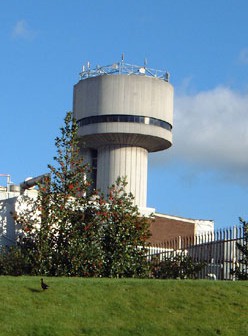THE hi-tech “microscope” that helped give the world new medicines, safer aircraft and even the iPod has been turned off for the last time at Warrington’s Daresbury Laboratory.
All these things have been made possible thanks to world leading research carried out on the Synchrotron  Radiation Source (SRS) at the laboratory.
Radiation Source (SRS) at the laboratory.
Probably SRS’ most famous achievement is the critical role it played towards a share of a Nobel Prize in chemistry for Sir John Walker in 1997, for solving a structure of an enzyme that opened the way for new insights into metabolic and regenerative disease.
The machine works by producing intense beams of light that reveal the structure of atoms and molecules inside materials.
After 28 years of operation and two million hours of science, the former world-first microscope was switched off for the last time during a special ceremony by one of its founders, Professor Ian Munro.
He said: “It is with immense pride and a great sense of achievement that I look back and contemplate the success of the SRS, not to mention the teamwork and expertise at Daresbury that went into building, maintaining and operating this great British scientific facility.
“Of course this is a sad occasion for me, but since the day the SRS was first switched on it has always been subject to a fixed life span and this day was always going to come. The SRS has kept the UK at the forefront of scientific research and now passes its baton onto the new Diamond Light Source in Oxfordshire, the UK’s direct successor to the SRS.
“Diamond will continue to build on the positive legacy of Synchrotron light research in this country.”
During its lifetime the SRS hosted over 11,000 users from academia, government laboratories and industry worldwide, leading to the publication of more than 5,000 research papers in leading journals, as well as resulting in patents that have solved in excess of 1,200 protein structures.
Since 1980, SRS paved the way for 60 similar machines to be built and has led to the development of new detergents, provided research for the memory facility of the iPod and even making chocolate taste nicer.
Professor Colin Whitehouse, the Science and Technology Facilities Council’s deputy chief executive and director of campus strategy said: “The SRS was one of the world’s most pioneering scientific inventions and Daresbury can be very proud of its outstanding achievements.
“Though the SRS has gone, Daresbury Laboratory is growing. It is part of a burgeoning national science and innovation campus and the home of the Cockcroft Institute, a national centre for accelerator science and technology, amongst other world-class research facilities. The Government’s recent announcement of £65M earmarked for Daresbury will provide two new additional science and technology gateway centres for computational science and engineering and detector systems. Daresbury will also continue its state-of-the-art accelerator science and technology research programmes based on the continuing operation of the Energy Recovery Linac Prototype known as ALICE, a technology which already offers important prospects for new cancer treatments.”
Hi-tech microscope closes down
00 Comments
Share.




